
 | SOCO Blog |
26 April 2016
THE SPRING TRIANGLE
For astro-imagers like myself, spring in the Northern Hemisphere is a time for imaging galaxies. The constellations of Virgo, Coma Berenices, Leo, Canes Venatici, and Ursa Major abound with a wide variety of galaxies, many suitable for viweing with modest-size telescopes. But, in addition to these galaxies, Spring skies also contain some of the finest and best-known globular clusters. On the night of April 14, I was able to capture two of them— M 5 (NGC 5904) and M 13 (NGC 6205). Weeks earlier, on February 9, I captured M 3 (NGC 5272). These three clusters are spectacular objects, the finest of their type in the spring skies. Okay, I'm not ignoring Omega Centauri (NGC 5139)— it's just that it lies so close to the horizon for many observers in North America, it is not the easiest to capture (it stays below 10 degrees above the horizon at the latitude of SOCO). So I'm leaving Omega Centauri for a later date, and concentrating for now on these three high-elevation clusters.
It was only after I acquired and processed the imagery for these three clusters that I realized a curious feature— these three clusters have positions in the sky that mark the vertices of an almost-equilateral triangle (see Figure 1). This "Spring Triangle" rides high in the sky on late Spring nights.
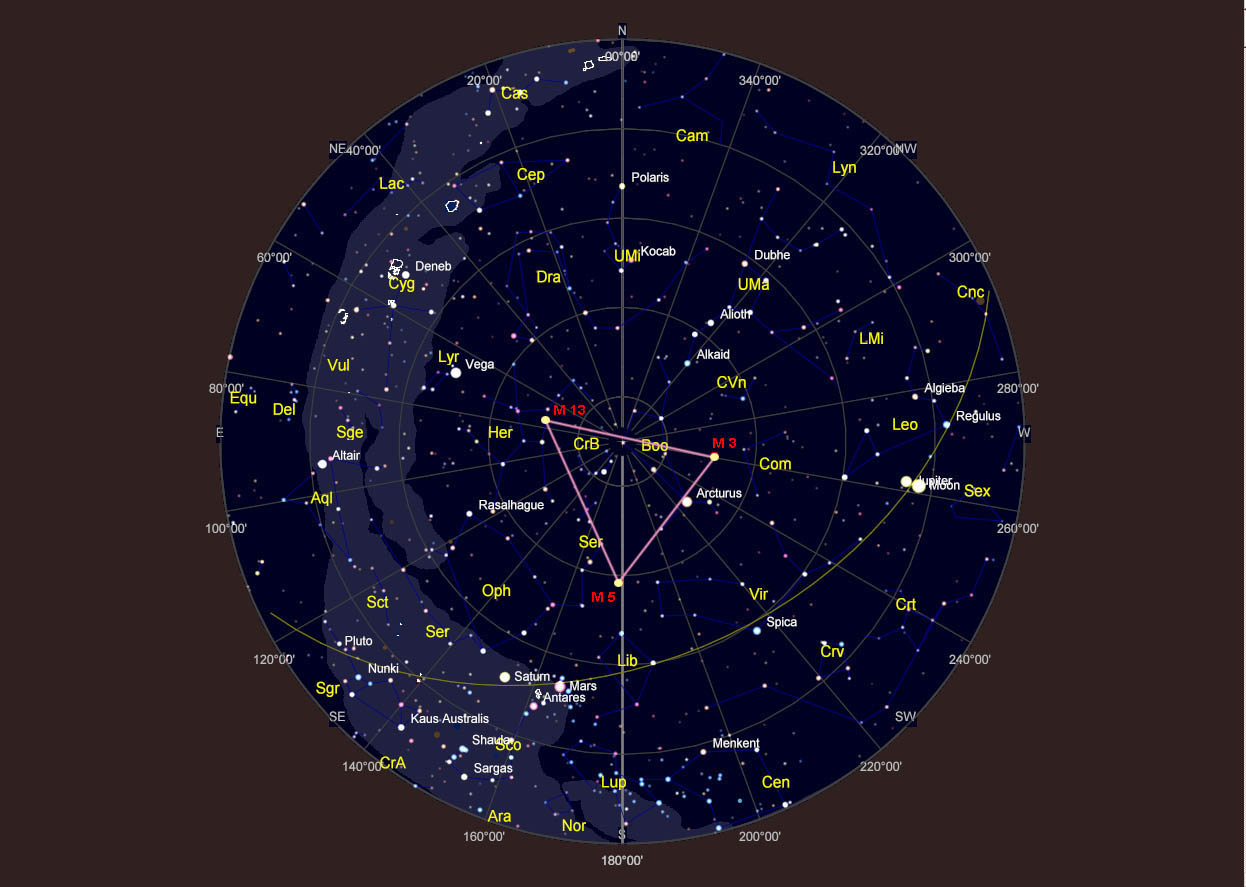
Figure 1. The "Spring Triangle" formed by the globular clusters M 3, M 5 and M 13 (16 May, 1:30 AM CDT).
Source: Adapted from Cartes du Ciel.
The first of out triangle targets is M 3 (Figure 2) lying close to the bright star Arcturus in the constellation Canes Venatici. M 3 lies at a distance of 34,170 LY from us. It has a visual diameter of 19 arc-min and a physical diameter of around 190 LY. It contains around a half-million stars, with a total mass equivalent to 800,000 Suns. With a visual magnitude of 5.9, it lies on the verge of visibility with the naked eye. The brightest stars in M 3 reach a visual magnitude of 12.7, but M 3 tends to be more difficult to resolve than M 5 or M 13— a 4-inch scope or larger is needed. M 3 is the first of our trio to rise, and is directly overhead at midnight (midnight culmination) on May 14.
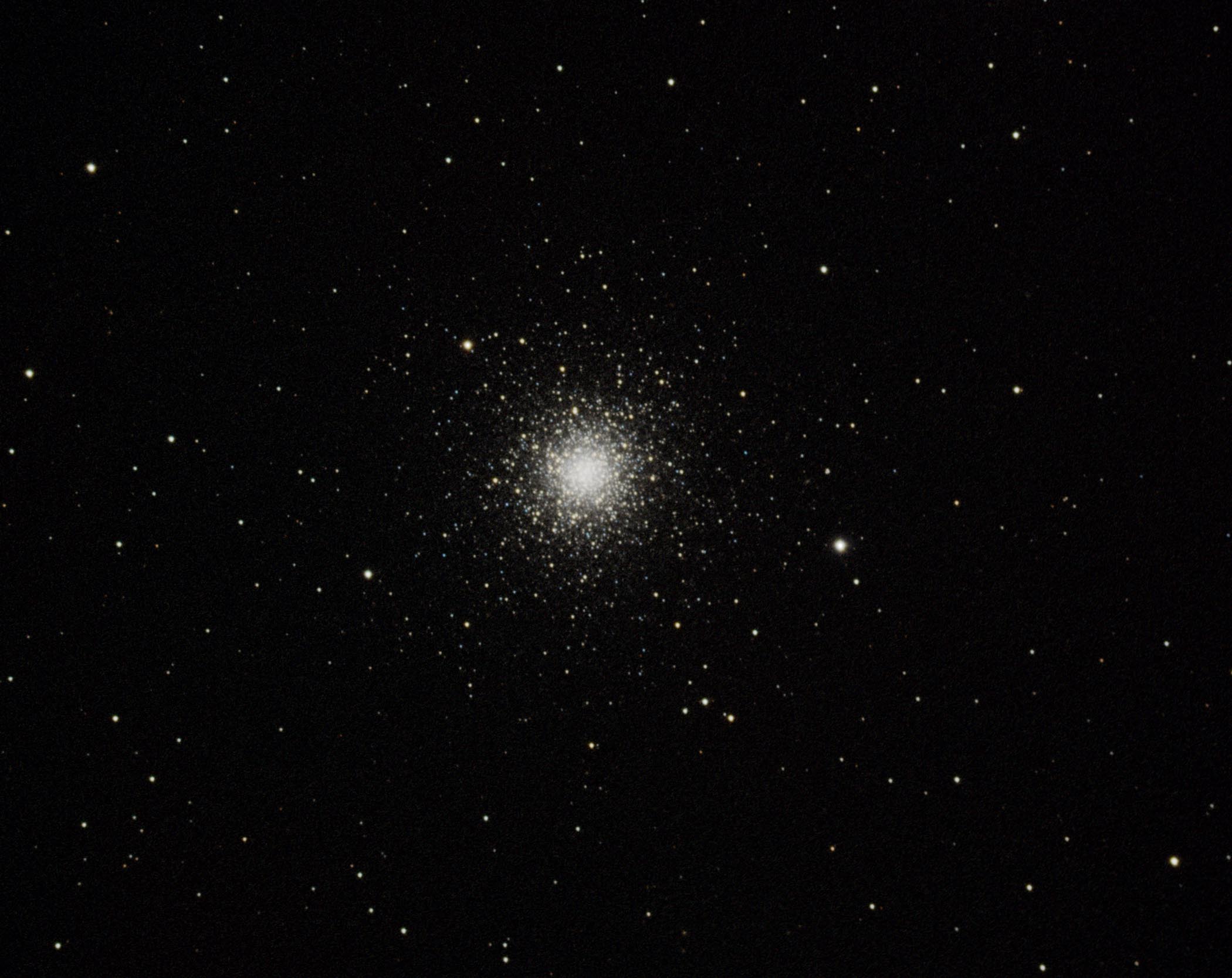
Figure 2. M 3 (NGC 5272) in Canes Venatici.
The next of our globular clusters is M 5 (Figure 3) lying on the western edge the constellation Serpens Caput (the head of the serpent carried by Ophiuchus, the Serpent Bearer). M 5 lies at a distance of 26,620 LY. It has a visual diameter of 20 arc-min and a physical diameter of around 150 LY. Like M 3, it has a total mass equivalent to 800,000 Suns. With a visual magnitude of 5.7, it lies on the verge of visibility with the naked eye, although such observations are exceedingly difficult. The nearby 5th-magnitude star 5 Serpentis (seen along the bottom of Figure 3) hampers the observation. The brightest stars in M 5 reach a visual magnitude of 12.2— you can begin to resolve it with a scope of only 2-3 inches diameter. M 5 rises later tham M 3, and has a midnight culmination on June 7.
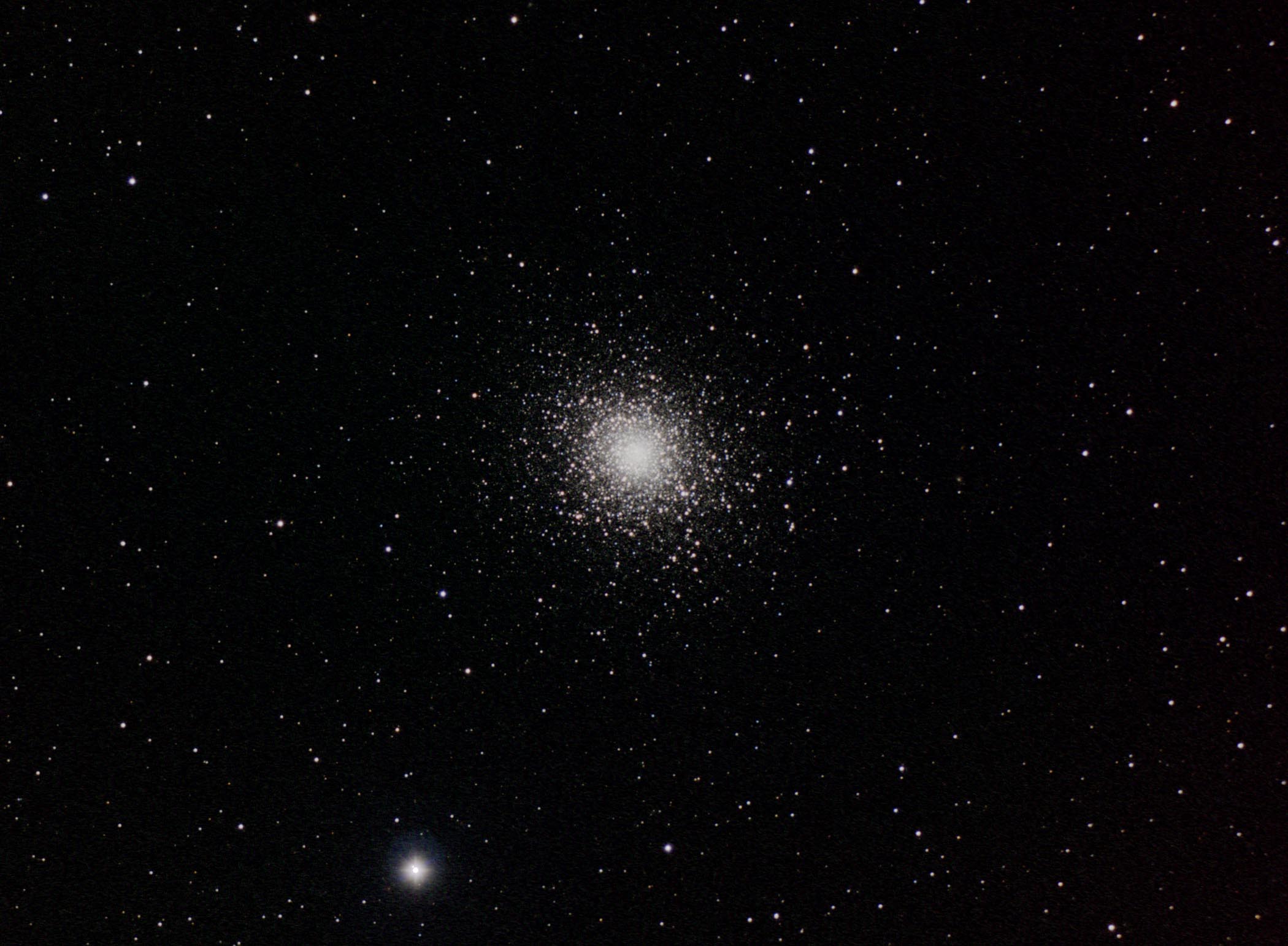
Figure 3. M 5 (NGC 5904) in Serpens Caput.
The remaining member of our trio is M 13 (Figure 4) in the constellation Hercules. M 13 is often called the "Great Hercules Cluster" and is probably the best-known globular cluster. M 13 is the closest of the three clusters, lying at a distance of 25,890 LY. It has a visual diameter of 21 arc-min and a physical diameter of around 160 LY. It contains on the order of a million stars and has a total mass equivalent to 600,000 Suns. With a visual magnitude of 5.7, it lies on the verge of visibility with the naked eye, and such observations have been reported under clear, dark sky conditions. The brightest stars in M 13 reach a visual magnitude of 11.9. Like with M 5, M 13 can be resolved with a scope of only 2-3 inches diameter. M 13 has a midnight culmination on June 28. In addition to the cluster, Figure 4 shows a distant but relatively bright galaxy (NGC 6207) along the upper left edge of the image.

Figure 4. M 13 (NGC 6205), the Great Hercules Cluster.
Globular clusters form a halo around our Milky Way Galaxy. The position of M 3, M 5 and M 13 relative to the disk of the Milky Way Galaxy is shown in Figure 5. All three circle our galaxy in orbits that take them high above the galactic plane. Currently, M 3 is the highest, with a separation of 33,509 LY between it and the galactic plane. So, when we look up at the Spring Triangle of globular clusters, we are looking outward from our galaxy toward intergalactic space. This can also be appreciated by looking at Figure 1— in this view of the sky, the three clusters are separated from the stream of the Milky Way, which represents our view down the disk of the galaxy. So, the Spring Triangle floats above our heads and above the disk of our galaxy.
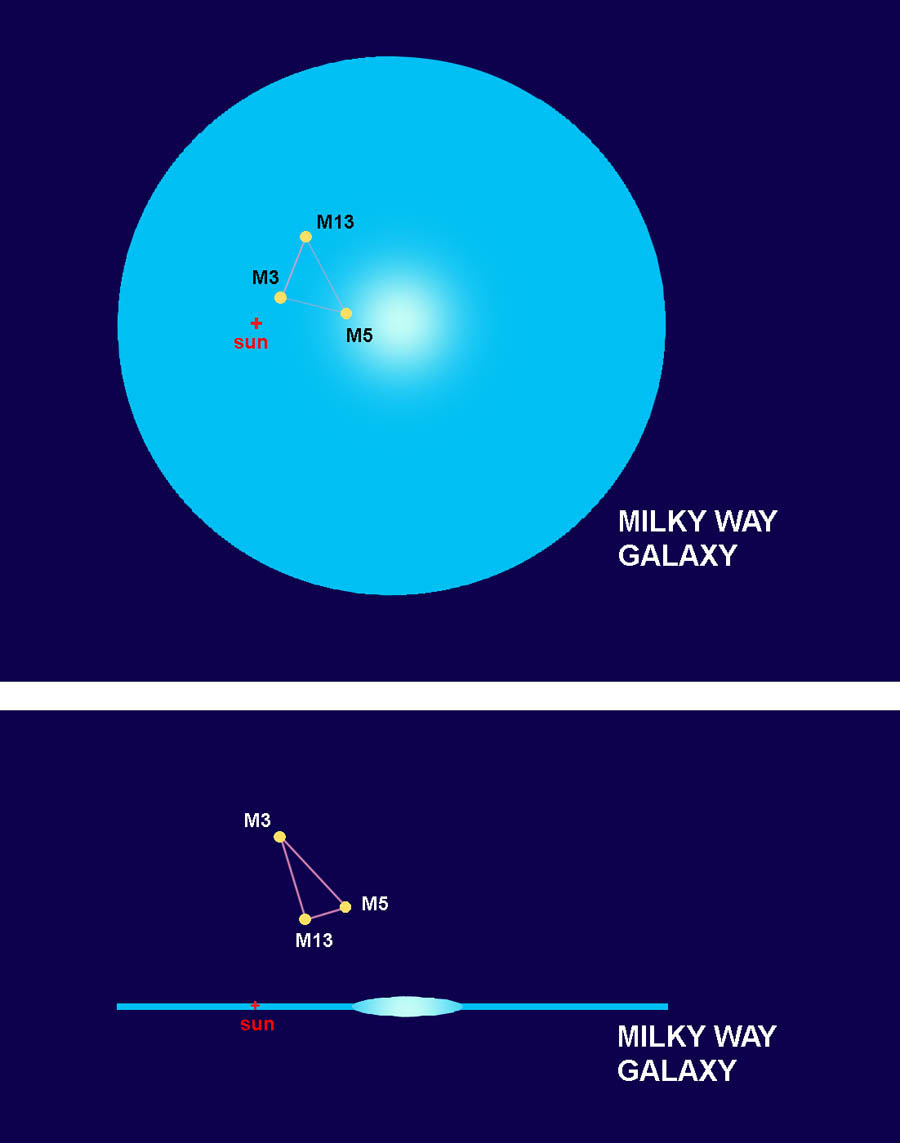
Figure 5. The locations of M 3, M 5 and M 13 relative to the disk of the Milky Way Galaxy; (Top) Overhead view of the Milky Way Galaxy showing the positions of the three clusters relative the the galactic center; (Bottom) Side view of the Milky Way Galaxy showing the height of the clusters above the galactic plane. The red cross shows the position of our Sun in the Milky Way Galaxy. The diameter of the Milky Way Galaxy in this representation is 110,000 LY.
All galaxies appear to have halos of globular clusters around them. Our Milky Way Galaxy has around 150-200 globular clusters. The Andromeda Galaxy (M 31), our "sister" spiral galaxy, has around 300-600. However, some galaxies have many more— the giant elliptical galaxy M 87 has a halo of around 12,000 globular clusters surrounding it. The orbits of globular clusters can take them far away from the main body of the galaxy. The distance between M 3 and the center of our galaxy varies between 15,000 and 50,000 LY over its orbital period of 300 million years. Similarly, M 13 and M 5 can travel out as far as 80,000 and 150,000 LY, respectively, from the galactic center. For some globular clusters, this can be much greater— NGC 2419 currently lies at a distance of 300,000 LY from the galactic center, and its orbit (which takes around 3 billion years to complete) takes it out beyond the Magellanic Clouds (two of the Milky Way's companion galaxies). This feature has gained NGC 2419 the name, the "Intergalactic Wanderer."
Globular clusters are some of the oldest objects in the Universe. They are thought to have condensed from primordial clouds of gas early in the history of the Universe and were later gravitationally captured by galaxies. Thus, the age of globular clusters are considered as a lower limit to the age of the Universe. Because these objects are so old, and since they don't contain a lot of gas for new star formation, the stars comprising them are predominently yellow-ish to red-ish late main-sequence stars (as compared to the young blue-white stars making up open clusters like the Pleiades). Still, if you look closely at the images of globular clusters, it's possible to see a scattering of blue-ish stars mixed in with the rest. These have been called "blue stragglers" and are thought to have been formed by the merger of individual stars in the crowded environment of the cluster.
Some dark features within the globular clusters have also been reported by observers. Perhaps most notable is the dark "Y-shaped" feature in M 13 originally described by Lord Rosse in 1851. This feature does show up in images of the cluster. Figure 6 shows its position in my image of M 13. This feature might result simply from differences among the spatial densities of stars within the cluster. Or, it might be due to intervening dust clouds— the outermost lobe of this feature does look like a real object in my image (and images by others) and not just an optical illusion. Quite a few "blue stragglers" can also be seen in this enlarged image.
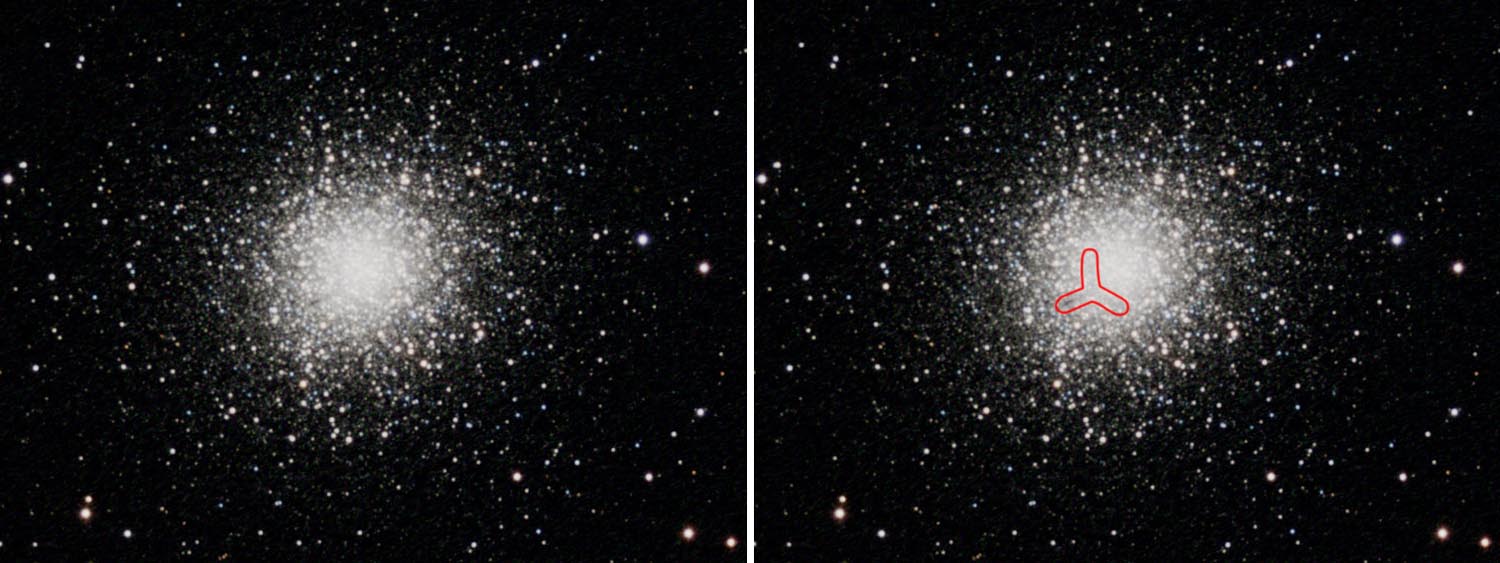
Figure 6. Enlarged view of M 13 showing the Y-shaped dark structure.
There are numerous globular clusters to be seen in the night sky, but the "Spring Triangle" provides the opportunity to observe three of the very best in the same evening.
 Return to SOCO Blog Page
Return to SOCO Blog Page
 Return to SOCO Main Page
Return to SOCO Main Page
Questions or comments? Email SOCO@cat-star.org